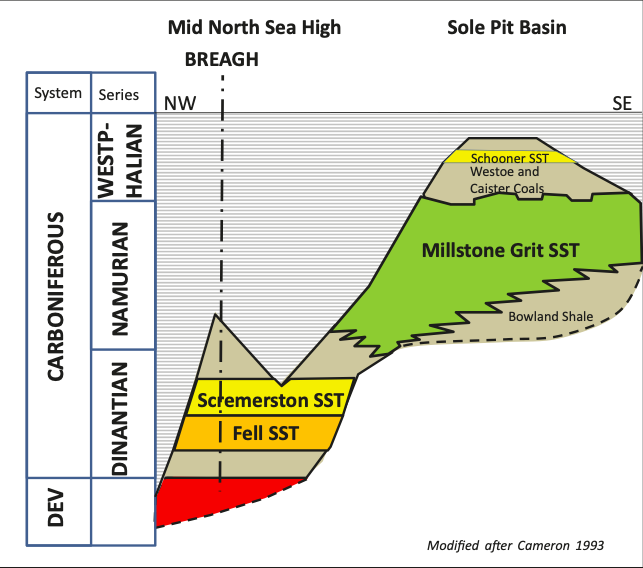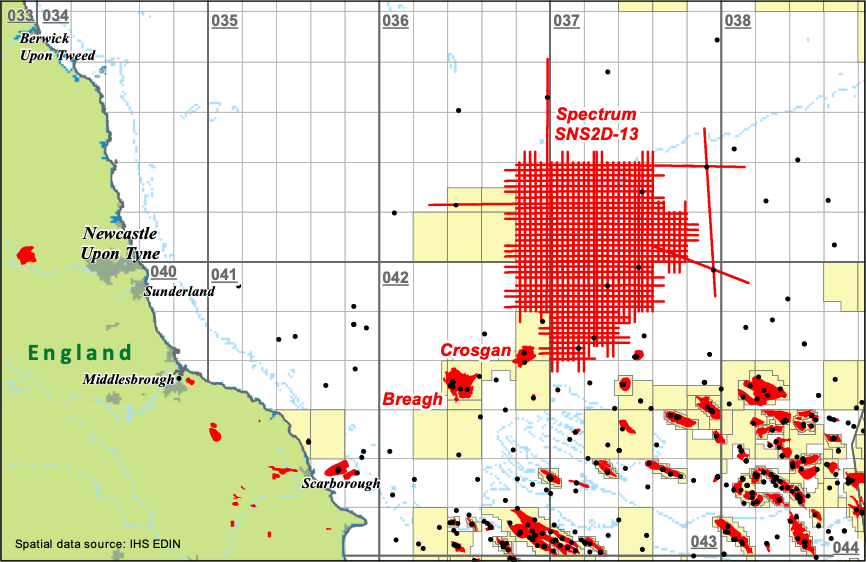New data reveals potential
The northern parts of Quads 42 and 43 in the UKCS Southern North Sea have received limited exploration to date. New data in open acreage north and east of the Crosgan and Breagh fields images the geology clearly and has allowed promising structures to be mapped.
Lying north and east of the Permian Rotliegend Sandstone play fairway in the UKCS Southern North Sea, the northern parts of Quads 42 and 43 have had cursory inspection in the past, usually by explorers seeking either Triassic plays adjacent to gas migration pathways through the Permian evaporites, similar to the Esmond and Forbes fields (about 20 km to the east), or Late Carboniferous Westphalian or Namurian delta-front plays such as the Cavendish and Trent fields. However, due to the geometry of the Base Permian unconformity, the Carboniferous is increasingly eroded to the north and the section encountered here is the sandstone-rich Dinantian (Early Carboniferous) Yoredale Formation (YF), Scremerston Formation (SF) and the Fell Sandstone Formation (FSF). The SF comprises reservoir quality channel sandstones up to 10m thick (42/13-3) with interbedded shales and thin coals. The underlying FSF is a more sand-rich reservoir comprising thick, high net-to- gross sandstones, with individual units up to 40m thick andanaverageporosityof17%(43/5-1).

New play fairway
The first well into the Breagh field (42/13-2), drilled by Mobil in 1997, encountered just such an SF section – finding 20m net pay in a 120m column and testing at non- commercial rates (3 MMcfg/d). However, interpreting the low flow rates to be due to drilling-induced reservoir damage, in 2007 Sterling Resources drilled the 42/13-3 appraisal well that encountered 23m of net pay in a 90m column, and without damaging the formation they tested at commercial flow rates (17 MMcfg/d). Subsequent appraisals reported up to 26 MMcfg/d flow rates (from a horizontal completion), and the field was brought on production in Q3 2013. The adjacent Crosgan field was discovered by Total with well 42/15a-1 in 1990, and awaits appraisal prior to development as a satellite to Breagh. The Breagh 2P reserves are reported at 604 Bcf and P50 contingent resources for Crosgan are 101 Bcf respectively, establishing the potential of this new play fairway for significant discoveries.
Regional depth mapping of the base Permian in the northern gas basin reveals a generally simple south-dipping monocline, except over the Breagh- Crosgan area, which stands out as a broad high. Little progress could be made in identifying valid structures on trend to the north-east as legacy seismic data in the region is widely spaced, multi-vintage and generally poor quality due to the geological complexities of the section. In 2013, to facilitate exploration of the SF and FSF play fairways, 3,736 km of new 2D multiclient data was acquired by Spectrum over open acreage north- east of the Breagh-Crosgan fields. These data were collected with an 8 km cable, nominal 160 fold with 10 second record length. This has enabled a dataset of extraordinary seismic quality to be assembled over the area, which images the Triassic, Permian and intra-Carboniferous sections with great clarity and has allowed base Permian structures (similar to Breagh field) to be mapped in open acreage and intra-Carboniferous fault block potential to be assessed.
Early carboniferous play
Reservoir play-fairway mapping can now identify where SF (and in places FSF) lies at the base Permian unconformity as the new seismic images the intra-Carboniferous reflec- tors for the first time with confidence. The Dinantian play comprises the following key elements:
Reservoir: SF or FSF sub-cropping the base Permian or in fault block structures. Reservoirs range from
interbedded sandstones and coals to thick, stacked delta top channel sequences. Evaluation of the new seismic data is only preliminary and yet already suggests that intra- formational facies mapping may be possible for the first time, highlighting channel belts and reservoir sweet spots.
Charge: The Early Carboniferous play relies on gas sourced from Westphalian Caister and Westoe Coal Formations in the Sole Pit Basin to the south, migrating laterally up-monoclinal dip below the Zechstein salt seal. One of the more intriguing applications of the new data is to map the location of welds in the salt where gas migration may be possible into the Triassic system and top seal may be locally challenged. Sub- Permian plays further north on the Dogger High are likely to have top seal issues due to thin Zechstein, and this is complicated by local halokinesis.
Trap: SF/FSF play top-seal is provided by Zechstein salt, above four-way dip closed structures, potentially with a stratigraphic erosional unconformity component. The 2013 seismic allows detailed facies mapping within the Zechstein sequence, clearly differentiating the halite and anhydrite dominated sequences. Interbedded shales provide intra- Carboniferous seal potential for tilted fault blocks and anticline structures.
The SF and FSF plays can work if intra-Carboniferous shales provide top-seal for Carboniferous structures or if the SF/ FSF subcrops the base Permian Zechstein evaporite seal and there is no lower Permian Silverpit or Rotliegend Formation waste zone. Although relatively few wells have penetrated the SF and FSF, mapping the base Permian subcrop of the Dinantian across the northern margin of the Gas Basin has been attempted using published well data (Maynard and Dunay, 1999). This work has been verified by Spectrum in a study of 42 released wells in the area, many of which (for example 41/10-1, 42/10b-2, 42/13-3 & 42/15a-2, 43/5-1) demonstrate the key play elements. A broad north- west to south-east trend of Early Carboniferous subcrop to base Permian extends through and to the north-east of the Breagh area into open acreage. The limit of the play fairway is defined by wells in the south of Quad 42 and 43 which encountered younger mudstone-prone (Westphalian and Namurian) units that are characterised by sandstones with poor visible porosity and low permeability.

These key play elements were mapped using conventional play-fairway analysis. Combining these three play elements indicates that the low-risk common risk segment of the SF/ FSF play fairway extends in a band spreading north-east from Breagh-Crosgan into open acreage.
With over 750 Bcfg of resources discovered to date in this play-fairway, the yet-to-find based on Spectrum’s preliminary structure mapping of the new dataset is over 1 TCF. As yet unquantified Triassic potential is a secondary target. This potential dwarfs that of the remaining exploration potential of the mature Permian and Carboniferous basins to the south.
Following first gas production from the Breagh field in September 2013, the commerciality of the Early Carboniferous play on the northern margins of the Southern Gas Basin is proven. New, high quality, dense 2D seismic is available to high-grade the prospectivity of these plays previously unimaged on poor legacy seismic, providing a new tool for explorers to use to aggressively compete for acreage in the 28th UKCS Licence Round in 2014.
References
BGS, 1993, Lithostratigraphic nomenclature of the UK North Sea: Carboniferous and Devonian of the Southern North Sea, http:// www.bgs.ac.uk/downloads/browse.cfm?sec=1&cat=195
Maynard, J.R., and Dunay, R.E., 1999, Reservoirs of the Dinantian (Lower Carboniferous) play of the Southern North Sea, Petroleum Geology of North West Europe, Proceedings of 5th Conference, 729-745, Geological Society, London Conference series
Spectrum, 2013, SNS Carboniferous Prospectivity Evaluation
Sterling Resources, 2008, 42/13-3 Subsurface Evaluation Report. www.sterling-resources.com/reserves/2013/rr20130521.pdf





